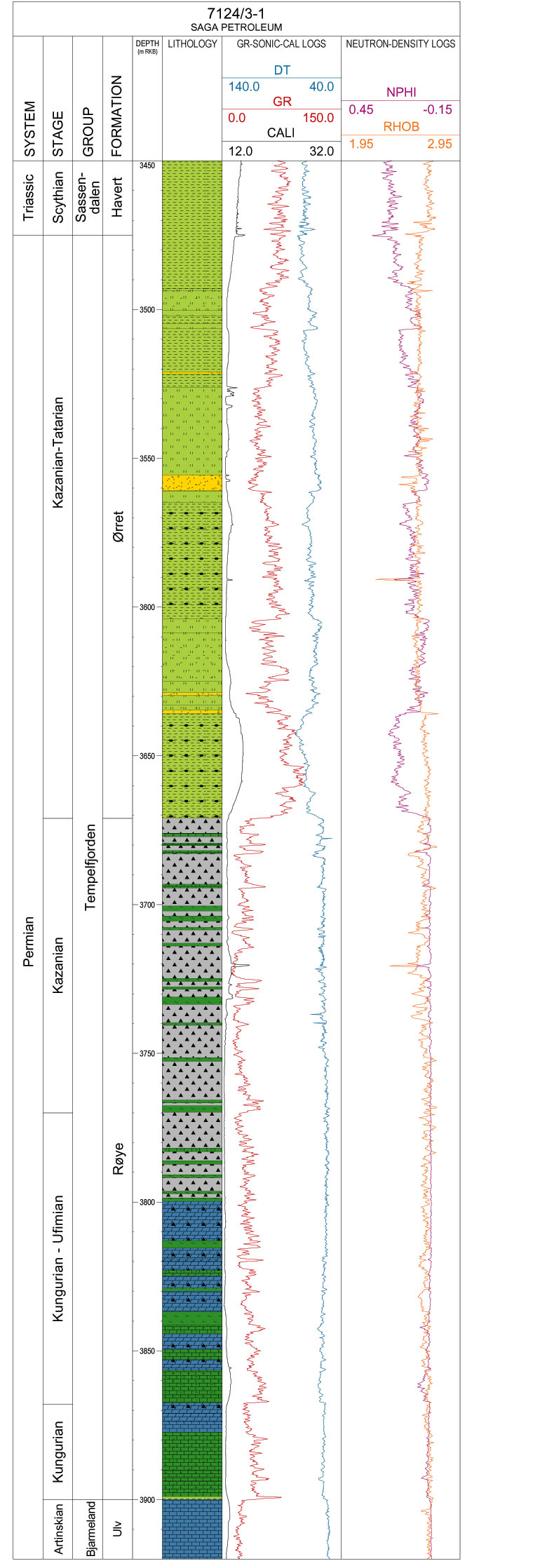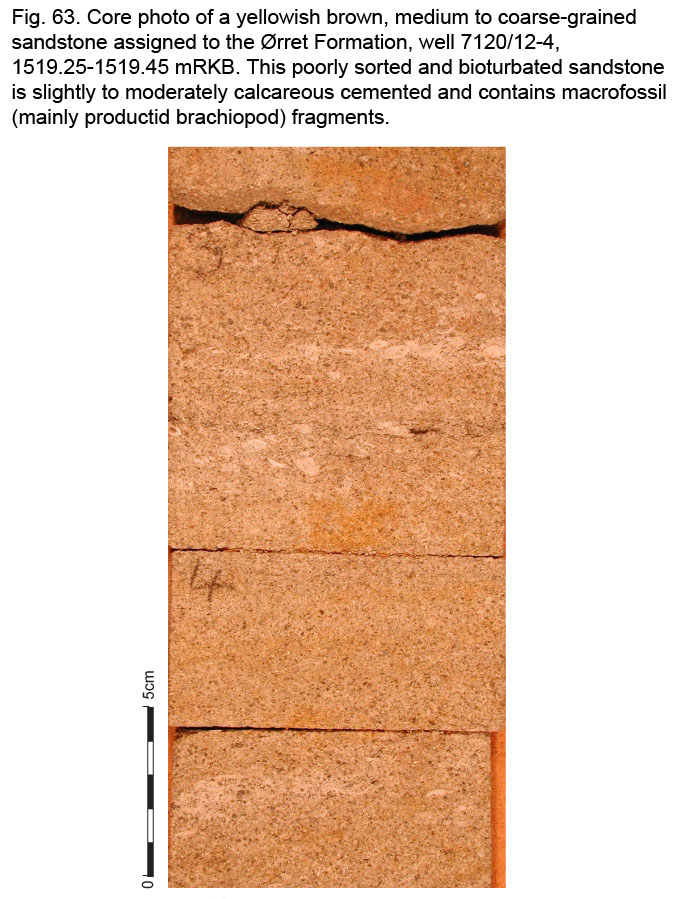 |
|
 |
|
From the Norwegian name for the Brown Trout (Salmo trutta).
The type section is defined as the interval from 3670 m to 3475 m in 7124/3-1 on the
Bjarmeland Platform (Fig. 62, Table 1). The base of the formation is characterised by a
sharp increase in gamma ray log response accompanied by increasing neutron and sonic
log readings in the type section where the formation overlies silicified limestones of the
Røye Formation (Fig. 62).
Fig. 53. Well logs of the type section of the Røye Formation in 7128/6-1.
For explanation of symbols see Fig. 3.

Reference sections:
In Loppa well 7120/1-1 with base at 2604 m, interfingering with a typical Røye development from 2458 m to 2430 and again overlain by the Røye Formation until the contact with overlying Triassic shales at 2402 m (Fig. 51, Fig. 55), from 3966 m to 3884 m in 7228/9-1S on the northern margins of the Finnmark Platform (Fig. 57).
As in the type section, the base of the formation is defined by a sharp increase in gamma ray log response accompanied by increasing neutron and sonic log readings in reference well 7228/9-1S (and in 7229/11-1) on the northern Finnmark Platform, where the formation also overlies silicified sediments of the Røye Formation (Fig. 51, Fig. 57).
The formation is 195 m thick in the type well and has an aggregate thickness of 173 m in 7120/1-1 on the Loppa High, whereas it is interpreted as not being developed in nearby well 7121/1-1. On the northern Finnmark Platform it is 82 m thick in well 7228/9-1, only 22 m in 7229/11-1 (Fig. 51) and disappears northwards so that wells 7128/4-1 and 7124/6/1 and cores 7128/12-U-01 and 7129/10-U-01 on the central and southern Finnmark Platform show only the Røye Formation directly overlain by Triassic shales. Tentative interpretations on the southern margins of the Hammerfest Basin in wells 7120/12-2 and 7120/12-4 suggest cumulative thicknesses of 656-901 metres.
The formation is dominated by siliciclastic sediments and includes sandstones, siltstones
and shales. The more fine-grained lithologies dominate. The sandstones (Fig. 62) appear as
isolated thin beds, or as up to 35 m thick sandy units, or in intervals with numerous thin
sandstone beds separated by shales. The sandstones are particularly common in the upper
part of the Ørret Formation in 7120/12-2 (Fig. 58) and 7120/12-4 (Fig. 63). On the Loppa High and
further eastward, organic rich shales become progressively more important. Coal fragments
are reported from some levels in association with sandstones. The siliciclastics are, in
contrast to those of the Røye Formation, not silicified. Thin limestone beds are rare in the
formation.

The formation is thickest in the deeper basinal and outer ramp areas of the Hammerfest Basin and the Finnmark and Bjarmeland platforms. Updip on the Finnmark Platform and the Loppa High it passes into the shallow marine carbonates of the Røye Formation. The transition from thin and organic-rich shales with rare thin sandstone and limestone beds in the east (7124/3-1, 7226/11-1, 7228/9-1 and 7229/11-1) to thicker, more silty and sandy and less organic-rich lithofacies in wells 7120/12-2 and 7120/12-4 in the southwestern Hammerfest Basin and Finnmark Platform, suggests a southwesterly-located siliciclastic provenance area. In these southwestern wells, where the formation is thought to interfinger with the Røye Formation, the basal transition is always characterised by a sharp increase in gamma ray log response reflecting the transition from silicified carbonates to fine-grained non-silicified siliciclastics (Fig. 58 and Fig. 62).
A ?Kungurian to ?Tatarian age is suggested by correlation to lateral equivalents.
Deposition took place in a variety of siliciclastic-dominated environments ranging from deltaic and lower coastal plain environments in the southwestern Hammerfest Basin to deep shelf environments on the southern Bjarmeland Platform and the northern Finnmark Platform. Dysoxic to anoxic conditions occurred locally in the deeper shelf settings to the east.